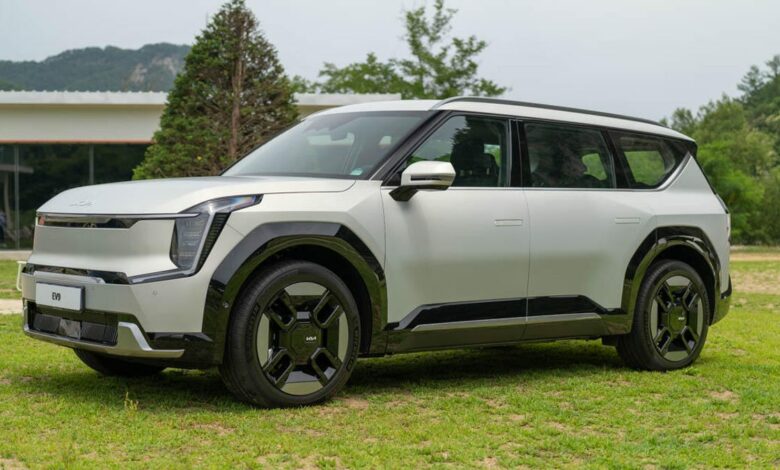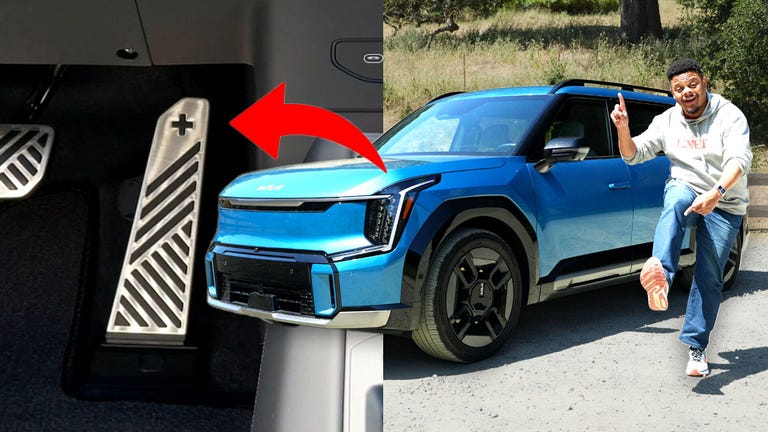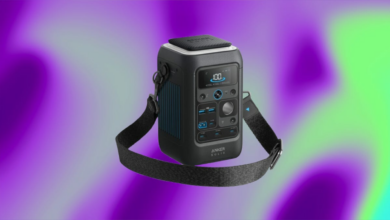2024 Kia EV9 Review: Lightning Strikes Thrice




Pros
- Super fast charging and respectable range are a strong combo
- The V2L 120V power output is even more useful paired with the big battery pack
- Even the base trim levels feature a strong suite of driver aid and cabin tech
Cons
- Subscription and paid DLC features feels like a slippery slope
- Does not currently qualify for federal plug-in incentive
Kia’s second dedicated battery electric vehicle was almost guaranteed to be a hit. Combining the best parts of the highly desirable three-row Telluride with the underpinnings of one of our favorite electric cars, the EV6 crossover, the Kia EV9 arrives on US roads at a time where EV adoption is steadily gaining steam and American buyers are SUV crazy. I hit the road in a fully-loaded 2024 Kia EV9 GT-Line to put my theory to the test.
Like its smaller stablemate, the EV6, the EV9 is built around Hyundai Motor Group’s E-GMP electric vehicle platform, so much of the technology found in its dashboard, safety suite and powertrain are familiar and the general design philosophies are similar. That said, the EV9 brings more than just a “super size me” to the table debuting updates to the user interface and infotainment software, thoughtful SUV-focused features and a new “software-driven” approach to features that — for better or worse — gives owners more ways to customize their EV’s look and performance at the touch of a button.
Performance, range and efficiency
The EV9 is available in three electric powertrain configurations. At the entry point, the Light RWD model starts out with a 160-kilowatt motor that drives the rear wheels to the tune of 215 horsepower and 258 pound-feet of torque matched with a 76.1-kilowatt-hour battery. Upgrading to the Long Range battery (optional for the Light trim level and standard for Wind, Land and GT-Line models) swaps in a larger 99.8-kWh battery.
The top three trim levels also upgrade to standard dual-motor all-wheel drive, increasing to 379 hp combined and 443 lb-ft unless users opt for a “Feature on Demand” software update that bumps output to 516 lb-ft. A free performance trial is included at purchase, but owners will have to pony up a one time $900 payment via the Kia Connect app to retain the increased output for the lifetime of the vehicle. This feels weird, since it could mean your test drive experience feels different from the ownership experience. It also feels like another slip down the slope of buying hardware capable of features/performance that automakers lock behind post-purchase software locks or subscriptions. That said, I also don’t think most drivers will need the extra pound-feet and could save money by just not opting in. The top-spec GT-Line model comes standard with the performance boost and doesn’t require additional purchase.
Owners can also pay to unlock new patterns and themes for the EV9’s light signature.
Hustling my GT-Line example off the line in Sport mode eats into the EV range a bit, but rewards with a 0-60 mph sprint of around 5 seconds, which is impressive, but I was more interested in the up to 2.38 miles per kilowatt-hour (around 80 mpg equivalent) the EPA estimates for this spec. I averaged an even 3.0 mi/kWh during my week of testing with much of my driving in Eco mode and at lower, urban speeds. The most efficient EV9 Light RWD trim climbs to 2.63 mi/kWh or 89 mpge on the EPA’s cycle.
The EPA also estimates that the single motor EV9 Light will do 230 miles per charge with the standard range battery or 304 miles with the long range pack. Dual motor models drop to 280 miles between charges and the heaviest, feature-laden GT-Line steps down again to 270 miles. We’re not sure how opting for the Feature on Demand performance affects range, but I’d reckon that unless you’ve got a lead foot, it shouldn’t.
Both battery packs include Kia’s fourth-gen chemistry and heat pump thermal conditioning for optimal operation and charging speed in various climates. That helps maintain range during especially hot or cold days and improves battery longevity. Thermal management also comes into play for battery preconditioning to ensure it gets as close to its optimal 230 kW DC fast charging rate and powerful enough 800-volt station. That should be fast enough to fill the big battery pack from 10 to 80% in around 25 minutes.
With the addition of a towing package, dual-motor EV9 examples also claim up to 5,000 pounds of towing capacity, which Kia warns may “significantly reduce electric range.” But that’s the case when towing with any EV.
V2L bidirectional power
Like its E-GMP-based family members, the EV9 also supports vehicle-to-load via an adapter to power electronics or appliances via its onboard inverter. This bidirectional power technology allows the owner to convert the J1772 charging input to a NEMA 5-15 AC output, then plug any AC-powered device or appliance they wish into this normal home-type outlet as long as they don’t exceed the 1.8 kW maximum draw.

Watch this: EV One-Pedal Driving Explained in the Kia EV9
This feature is even more flexible when paired with the EV9’s big 99.8-kWh battery pack, which has enough capacity to keep a refrigerator or chest freezer running for a whole week, which could save a lot of food spoilage during an extended outage without making too much of a dent in the range for shorter ones. Software on the EV9’s dashboard allows a user to activate or disable V2L and set battery capacity reserve limits in 10% increments, so you’ll still have enough range to get home or to a charger after a day of tailgating or powering a campsite.
The EV9 also includes a second 1,800 watt V2L outlet in the rear cargo bay, a smaller low-power AC inverter in the center console and 7 high-speed USB type-C ports around the cabin to charge devices like laptops, tablets and game consoles on the go.
And in certain markets, the EV9 will also introduce vehicle-to-grid capability, which owners will set up and manage via the Kia Connect app marketplace, but that’s still a feature that’s “coming soon.” With its current 1,800 watt V2L limit, there’s not enough continuous juice to power your whole home like, say, Ford or Chevy’s vehicle to home setups or stationary battery installation could, but it’s still plenty useful.
Room for 6… or 7
I was surprised by the Kia EV9’s exceptionally low step in height for what looks like a big, tall SUV. The chassis sits only an inch higher on its suspension than the smaller EV6, which makes getting in and out extremely easy. This also yields benefits when it’s time to load heavy items into the rear hold and when installing and loading car seats.
The GT-Line model is handsomely appointed with two-toned interior upholstery.
On the other hand, I was disappointed to learn that one of the EV9’s most innovative features, the 180-degree swiveling second-row seats, doesn’t meet US Federal Motor Vehicle Safety standards and so won’t be available on US models. Bummer. We’ll have to make do with upgrading to the plush second-row sliding captain’s chairs with power-adjustment, deployable leg extensions and massage — a six-seater setup that seems to have evolved from our previous long-term Kia Carnival Prestige minivan.
Legroom is plentiful on the spacious second row and even the third row offers reasonable head and legroom for this 5-foot, 10-inch adult. The EV9 will come standard in a seven-passenger configuration with a folding second-row bench, as well. In addition to people, the EV9 also boasts ample space for cargo with 20.2 cubic feet of stowage behind the third row opening up to a cavernous 81.9 cubes with all rear seats folded.
Unfortunately, there’s not much underhood frunk space to be found, just a small bin that’s only big enough to store the charging cable or a few small items.
Revised dashboard tech
My GT-Line example featured heated and ventilated surfaces and a broad range of adjustment, extending into a full-on recliner lounge position with leg rests when parked for charging. The EV9’s available front seat massage function isn’t as targeted or firm as I’d prefer, but I loved how it periodically activates during extended driving sessions to relieve fatigue and boost awareness.
Ahead of the driver’s seat is the EV9’s monolithic triple-display infotainment suite, which builds on the automaker’s established dual-12.3 inch screens with a small 5-inch monochrome segment display with at-a-glance climate control information. Kia has once again revised its software, presenting the EV9 driver with a new, more personalized home screen that can display more information at a glance via customizable widgets and shortcuts. The new system features improved over-the-air update capability and compatibility with Android Auto, Apple CarPlay and Digital Key support for certain Android and iPhone devices.
The EV9’s new home screen features customizable widgets that display more information at a glance. To the left, you can also see the 5-inch segment display with climate control info.
Haptic capacitive touch shortcut keys for Map, Audio Source and more seem to disappear into the dashboard surface below — finished in wood veneer on my example — which is aesthetically nice, but can be difficult to accurately hit from the driver’s seat. Functionally, I’m glad these shortcuts are now completely separate from the dedicated physical buttons for temperature and fan speed control below. Overall, the dashboard feels like an organizational improvement over EV6’s already impressive formula.
The EV9 uses a very Hyundai Ioniq 5-like stalk shift knob mounted to the steering column to toggle between drive, park and reverse. Look closely and you’ll also note this dongle integrates the start button. This bit of space saving that frees up space on the center console for storage and more forward-positioned cupholders, which is nice.
If I can pick one more ergonomic nit, it’s the placement of the drive and terrain mode buttons on the EV9’s four-spoke steering wheel. Tucked low beneath the center hub, I found them more difficult to reach without awkwardly bending my wrist. I vastly prefer EV6’s big convenient drive mode button that falls within easy reach of a thumb at the 8 o’clock position. In Kia’s defense, the central location is more difficult to accidentally hit while shuffle-steering and the average EV9 driver with an SUV full of family members probably won’t bounce between drive modes as often as I do. But as a driver who enjoys quickly double tapping into Sport mode for a quick pass, I wish there were a middle ground here.
Like the similarly large Telluride, the EV9 is also available with a digital display rearview mirror, which greatly boosts visibility, especially when passengers’ heads or tall cargo blocks the back window.
Driver aid and parking tech
Kia has done a good job standardizing much of its driver aid technology. Right down to the base model, every EV9 comes standard with advanced adaptive cruise control, lane keeping/following assistance, and forward collision mitigation braking assist (which also monitors for crossing traffic at intersections), features that boost safety and reduce fatigue during longer drives. These are the latest generation of the automaker’s tech, which use machine learning to, for example, keep a natural distance between you and a car in the adjacent lane, rather than slavishly sticking to the exact center.
Also standard are blind spot monitoring with collision warning if you’re about to merge into an occupied lane, rear parking distance sensors, cross traffic alerts and the now legally mandated rear-view camera. Upgrading to the Wind trim level — the sweet spot, I’d say, for features and price — adds a surround view camera system that aids in parking precision, a feature called Blind Spot View Monitor that shows a camera view of the adjacent lane in the instrument cluster when activating the turn signal, as well as more parking safety features.
The top spec GT-Line model adds Remote Smart Parking Assist, a feature that’s as cool as it was when I tested the Hyundai Ioniq 5, but is even more situationally convenient here. After exiting the vehicle and activating remote start, drivers can hold a button on the key fob to remotely move the EV forward or backward in or out of a parking space. The EV9 can only move in a straight line and only when the driver is within a few feet of the car and no obstructions are detected by the parking sensors. This is handy for squeezing the big Kia into a small garage or backing out of a spot after some jerk’s parked too close for you to open your door, but it’s mostly a very cool party trick that I can’t imagine using much in public.
Price, availability, recommended options
The 2024 Kia EV9 starts at $56,395 for the entry-point Light RWD with the standard range battery, but I’d recommend considering the $60,695 Light Long Range RWD to get the improved range and efficiency of the bigger battery. At this trim, the EV9 is well-equipped enough that I think most frugal drivers would be more than satisfied — and if this were the EV6 or Ioniq 5, I’d say stop here — but I know how much SUV shoppers value power and all-wheel drive, making the EV9 Wind AWD ($65,395) the true sweet spot in the lineup, bringing a few nice-to-have safety features and upgrades along for the ride. All prices include the Kia EV9’s $1,495 destination charge.
As tested, fully-loaded and with $695 Ocean Blue Gloss paint, our GT-Line tester arrived with a $76,245 sticker — significantly more expensive than a comparably equipped, combustion-powered Telluride, but also significantly less than its fully-electric three-row competition, the Tesla Model X and Rivian R1S.
The EV9 comes standard with electric rear-wheel drive, but dual-motor all-wheel drive is available.
Currently, the lease loophole is the only way to get the full $7,500 tax credit, but if you prefer to buy and are patient, waiting a bit could also save you money on the EV9. The automaker recently moved assembly and production of the electric SUV to its West Point, Georgia plant, which means that it may meet eligibility requirements for the EV tax credit by 2025.
You should avoid the 2024 EV9 if…
The Kia EV9 is an excellent electric SUV and is plenty capable, but if you’re looking for actual “Sport Utility” from your SUV, perhaps Rivian’s recently updated R1S is a better fit. Significantly more expensive when comparably equipped, the R1S also boasts much better performance in off-road situations — and is available with more adventure-ready options, such as all-terrain tires, powerful triple- and quad- motor powertrains and unique campsite gear.
If you really don’t need three rows of capacity, stepping down to the still fairly spacious EV6 hatchback isn’t at all a downgrade. I recently spent a year behind the wheel of our long-term example and was very pleased with the range, the performance and both the ease and cost of ownership. Plus, the EV6 just got a facelift with improved performance and range and an upgrade to its dashboard technology that brings it inline with its big brother.
You can find even more EV options of all shapes, sizes and budgets in our Best EVs of 2024 buyers guide.
You should consider the 2024 EV9 if…
The EV9 shows that Kia knows what most SUV buyers are really looking for. It’s a comfortable and agile ride around town and on the highway, rather than a trail-focused compromise. It’s loaded with tech, but not so complicated that drivers need to relearn the dashboard to hit the road. It’s spacious and large, but accessible and unimposing. There’s enough range for most driver’s needs, super-fast charging to make longer trips painless and a price that feels right for the class. If you’re looking for an electric car with room for the whole family, the 2024 Kia EV9 is a great fit.
Vehicle Scoring Matrix: 2024 Kia EV9
| Performance (35%) | 9 |
|---|---|
| Media (25%) | 9 |
| Features (20%) | 8.5 |
| Design (20%) | 9 |
| Overall | 8.9 |
How we test electric cars
I’ve evaluated hundreds of conventional and electrified cars over the past 16 years, but the process always starts behind the wheel in real-world conditions on public roads. For each car I test, I cover over 200 miles on a mixed driving route that includes dense urban roads, long stretches of highway and some twisty mountain roads mixed in for fun and flavor.
For EVs, I keep a close eye on the electric range and the charging experience, taking into account differences between any available drive modes, such as eco, sport or comfort modes. Factoring this alongside the driving dynamics (handling, acceleration and braking), I compare each vehicle to the competition in its class and models often cross-shopped to get the Performance score.
Along the way, I also check each car’s cabin comfort, dashboard tech and driver aid and safety features (Design, Media and Features, respectively) to get a feel for where each vehicle fits in my experience testing hundreds of combustion, hybrid, hydrogen and, yes, battery-powered cars for CNET reviews.
Performance: The efficiency, range and charging experience of an electrified vehicle, factoring in driving dynamics and comfort relative to other vehicles in a specific class.
Media: The quality of the infotainment and dashboard technology, checking that desirable features (such as Apple CarPlay and Android Auto) are present, but also evaluating ease of use and organization, especially while in motion.
Features: Driver assistance and safety technologies, both standard and optional, are weighed for our Features score. We check that desirable features are available, but also how well they work relative to industry standards and competing models.
Design: Ergonomics, cabin comfort, available storage and more factor into the Design score. Unique features that make life easier and, to a degree, aesthetics also contribute to this category.
Editors’ note: Travel costs related to parts of this story were covered by the manufacturer, which is common in the auto industry. The judgments and opinions of CNET’s staff are our own and we do not accept paid editorial content.




